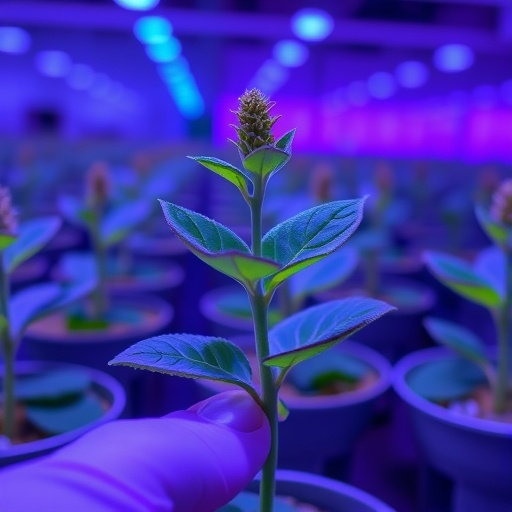Viral vector technology, central to this breakthrough, involves the deliberate modification of plant viruses. By excising pathogenic genetic elements, researchers transform these viruses into biological delivery systems capable of transporting specific RNA sequences into plant cells. Historically, this method has shown promise under controlled experimental conditions, enabling the induction of flowering, acceleration in the development of improved varieties, and the alteration of plant architecture to enhance mechanization adaptability. It has also contributed to boosting drought resilience and facilitating the biosynthesis of health-promoting secondary metabolites.
The current innovation, developed jointly by CSIC alongside the Valencian University Institute for Research on the Conservation and Improvement of Agrodiversity (COMAV) and the Italian Department of Applications and Innovation in Supercomputing (Cineca), optimizes viral vector platforms to expedite the experimental validation and practical application of agricultural biotechnologies. Fabio Pasin, a Ramón y Cajal researcher at the Margarita Salas Center for Biological Research (CIB-CSIC) and lead scientist on the project, highlights that their synthetic biology strategies are tailored for future industrial-scale implementations, promising scalability and cost efficiency.
.adsslot_cxioqsG1F2{width:728px !important;height:90px !important;}
@media(max-width:1199px){ .adsslot_cxioqsG1F2{width:468px !important;height:60px !important;}
}
@media(max-width:767px){ .adsslot_cxioqsG1F2{width:320px !important;height:50px !important;}
}
ADVERTISEMENT
This new technique, termed virus-mediated short RNA insertions (vsRNAi), breaks new ground in the utilization of viral vectors for agronomic trait modification. Utilizing benign plant viruses as carriers, the vsRNAi introduces ultra-short RNA fragments—significantly shorter than the conventional 300-nucleotide inserts—to trigger RNA interference (RNAi). RNAi serves as a natural mechanism within cells to silence specific gene expression, effectively preventing the translation of targeted genetic information into proteins. The reduced length of these RNA inserts streamlines the gene silencing process and enhances targeting precision.
The research team harnessed advanced comparative genomics and transcriptomics methodologies to design these 24-nucleotide sequences for plant gene silencing. Their approach markedly reduces the complexity and the physical size of viral constructs traditionally used for gene silencing, thereby accelerating experimental workflows and reducing costs. The shorter RNA insertions minimize off-target effects and increase specificity, yielding efficient downregulation of target genes with scalable potential for various crop species.
To demonstrate the efficacy of vsRNAi, the researchers targeted the CHLI gene, pivotal in chlorophyll biosynthesis. Viral vectors carrying RNA inserts sized between 20 and 32 nucleotides were introduced into model plants. The resultant phenotypic outcomes manifested as pronounced leaf yellowing due to reduced chlorophyll, confirming robust gene silencing. Deep sequencing of small RNAs indicated the generation of 21- and 22-nucleotide RNA products, signifying active RNAi pathways leading to transcriptional repression of the CHLI gene, effectively demonstrating the mechanism’s validity.
The applicability of vsRNAi was further tested within the Solanaceae family—an essential botanical group comprising numerous economically significant crops including tomatoes and potatoes. In particular, the technique showed outstanding performance in tomato and scarlet eggplant (Solanum aethiopicum), a lesser-utilized species with promising agronomic potential beyond its native African and Brazilian contexts. The potential extension of this technology to niche European cultivars, such as the Italian “Rossa di Rotonda,” underscores the broad spectrum impact of this gene silencing approach.
Among the prominent advantages of vsRNAi over existing RNAi modalities are its technical simplicity, specificity to target genes, absence of stable genomic alterations, and economic efficiency. This transient gene silencing negates the introduction of permanent genetic modifications, addressing regulatory and public concerns tied to genetically modified organisms (GMOs). Such features position vsRNAi as a revolutionary tool in molecular plant biology and agricultural biotechnology, especially relevant for non-model plants that traditionally lack extensive genetic resources or biotechnological tools.
The researchers foresee numerous applications of vsRNAi for rapid, on-demand modulation of crop traits and enhanced pest and disease management without the ecological footprint associated with classical genetic modification. This capability to transiently adjust phenotypes aids researchers in dissecting gene function and accelerates breeding programs by providing flexible trait enhancement strategies. The transient nature of vsRNAi offerings ensures sustainability while maintaining crop genetic integrity across generations.
From a functional genomics perspective, the portability of vsRNAi across diverse plant species facilitates high-throughput screening, enabling more precise dissection of gene function across a broad range of crops, including underutilized species. It also allows geneticists to explore complex trait architectures in an array of plants, ultimately contributing to more climate-resilient and nutritionally enriched crops adapted to various environmental challenges.
Importantly, the research illustrates how synthetic biology can converge with virology and plant science to engineer streamlined viral vectors with minimal genetic payloads yet high functional efficiency. These vectors have the potential to enhance mechanistic understanding of RNAi in plants and expand the toolbox for molecular crop improvement without the permanent insertion of foreign DNA, offering a middle ground between traditional breeding and transgenic technologies.
With agriculture facing intensifying pressures due to climate change, population growth, and the need for sustainable practices, innovations such as vsRNAi represent a timely technological leap. By fostering gene silencing that is controllable, reversible, and species-transferable, vsRNAi not only expedites research but also lays the foundation for next-generation precision agriculture, where crop traits can be modified dynamically in the field to meet environmental and market demands.
In summary, the development of virus-mediated short RNA insertions injects new momentum into plant biotechnology. By combining viral vector engineering, ultra-short RNA design, and synthetic biology principles, this technique promises to accelerate the development of improved crop varieties with tailored traits, fulfilling both scientific and practical ambitions in agricultural productivity, sustainability, and food security.
Subject of Research: Not applicable
Article Title: Comparative genomics-driven design of virus-delivered short RNA inserts triggering robust gene silencing
News Publication Date: 24-Jul-2025
Web References:
Plant Biotechnology Journal Article
DOI: 10.1111/pbi.70254
Keywords: Crops, RNA interference, viral vectors, gene silencing, plant biotechnology, functional genomics, Solanaceae, sustainable agriculture
Tags: advancements in agricultural biotechnologycrop yield improvement strategiescustomization of plant traitsenhancing drought resilience in cropsfunctional genomics in crop developmentgene silencing in plantsgenetic modification for sustainable practiceshealth-promoting metabolites in agricultureinnovative plant biotechnology techniquesplant architecture modification for mechanizationRNA sequences in plant geneticsviral vector technology in agriculture





